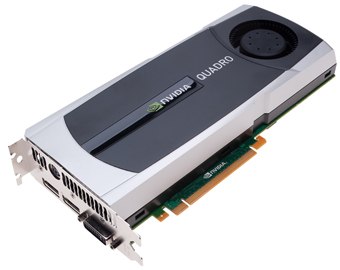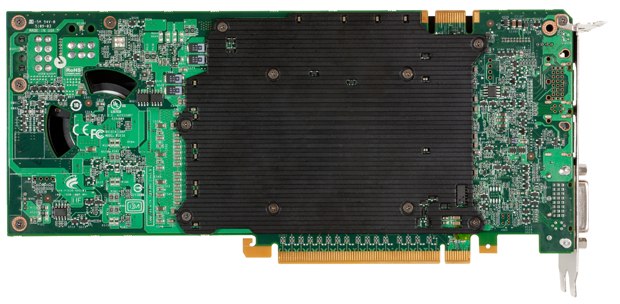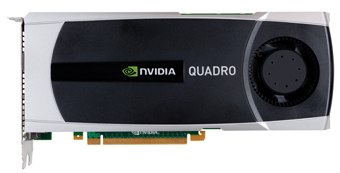Our reviewer test drives NVIDIA's new Quadro 6000 to find out if the highest of the new Fermi line of graphics cards has legs.
The first generation of NVIDIA's Quadro high-performance graphics cards based on their Fermi architecture is now available for the professional market. In this review, I had a look at the Quadro 6000, the successor to the Quadro FX 5800. With this line of Quadro cards, NVIDIA is dropping the FX designation long used for these professional-level graphic accelerators.
The Graphics Card The Quadro 6000 is a double-width graphics card measuring 4.376" high and 9.75" long. While the Quadro only uses a single PCIe 2.0 x 16 bus, the width of the display card makes the adjacent slot unusable. Two power connectors are necessary for the Quadro 6000, which has a maximum peak power consumption of 225W. Needless to say, this kind of wattage generates noticeable heat, even with the active thermal solution that's incorporated. This peak wattage, and the associated heat, is reached when very demanding models are being manipulated or rendered and is, thankfully, not a constant.
Onboard memory for the Quadro 6000 is 6GB of GDDR5 RAM, the highest yet offered from NVIDIA. Notably the memory is ECC memory -- ECC can be enabled or disabled via the NVIDIA control panel. The memory interface is 384-bit, with a memory bandwidth of 144GB/s.
The functionality of the Quadro 6000 can be expanded via hardware in several ways, among them the linking of additional graphics cards via an SLI bridge, a GenLock add on, and NVIDIA 3D Vision Pro wireless stereo glasses (3D min-DIN or USB), which are expected to ship early this autumn.
DisplayPort 1.1a, HDMI 1.3a and HDCP are supported, as is 30-bit color (10-bit per each red, green and blue channels), making this card pair well with the new HP DreamColor monitors. The 10-bit internal display processing is only available on Windows with Aero disabled and Linux.
With its new Scalable Geometry engine, NVIDIA's Quadro 6000 is capable of delivering up to 1.3 billion triangles per second, a rate that is obvious in production usage as well as in day-to-day operations.
Support is provided for any combination of two connected displays: Dual DisplayPort at up to 2560 x 1600 @ 60Hz and 1920 x 1200 @ 120Hz; Dual-link DVI-I output is supported at up to 2560 x 1600 @ 60Hz and 1920 x 1200 @ 120Hz. Available cables are DisplayPort to VGA, DisplayPort to DVI-D (single-link and dual-link) and DisplayPort to HDMI (resolution support based on cable specifications).
The NVIDIA Quadro 6000 offers full OpenGL and quad-buffered stereo support, as well as underscan/overscan compensation wand hardware scaling. Multi-display capabilities are provided with NVIDIA nView multi-display technology and NVIDIA SLI Mosaic technology.
Shader Model 5.0 (OpenGL 4.0 and DirectX 11) is supported, with up to 16K texture and render processing. Other features are 32-bit per-component floating point texture filtering and blending, and 64x full scene antialiasing (FSAA) with 128x FSAA in SLI mode. There are 448 CUDA parallel processing cores onboard.
Decode acceleration is offered for MPEG-2, MPEG-4 Part 2 Advanced Simple Profile, h.264, MVC, VC1, DivX (version 3.11 and later) and Flash (10.1 and later). Blu-ray dual stream hardware acceleration is supported by the Quadro 6000, with HD picture-in-picture playback.
Programmability
While the hardware features of the Quadro 6000 make it useful for a broad array of professional endeavors, the programmability options provide good depth for DCC professionals.
NVIDIA offers an optimized compiler for Cg and Microsoft HLSL, along with Full IEEE 754-2008 32-bit and high performance 64-bit double precision. API support includes CUDA C, CUDA C++, DirectCompute 5.0, Java, Python and Fortran.
The NVIDIA CUDA parallel processing architecture includes Parallel DataCache hierarchy, with configurable L1 and unified L2 caches and configurable partitioning of shared memory and L1 cache; a dual Warp Scheduler schedules and dispatches simultaneous instructions from two different warps.
A number of modern applications are capable of accessing the CUDA parallel processing architecture of the Quadro 6000 to deliver up to 8x faster performance, according to NVIDIA, when running such computationally intensive applications as ray tracing and video processing.
Supported Platforms
Supported platforms include Microsoft Windows 7 (32-bit and 64-bit), Microsoft Windows Vista (32-bit and 64-bit), Microsoft Windows XP (32-bit and 64-bit), Linux --full OpenGL implementation with NVIDIA and ARB extensions (32-bit and 64-bit) -- and Solaris. Accelerated performance drivers for both AutoCAD and Autodesk 3ds Max applications are expected to be available shortly. Support is provided for two operating systems, from a Quadro SLI Multi-OS certified workstation, with each operating system assigned to a dedicated Quadro GPU. A robust support organization provides fast help when problems do arise.
Testing
I tested the NVIDIA's Quadro 6000 with the SPEC Viewperf 11 benchmark (www.spec.org), the latest revision of this industry standard benchmark. The system used for all testing was an Xi MTower PCIe Workstation with a single Intel Core2 Duo E8400 3.2GHz processor and 4GB of system RAM installed, running Microsoft Windows 7 Ultimate X64 with the latest patches and revisions installed; NVIDIA WHCL drivers v.8.17.12.5912 (7/26/2010) were used for testing. Vertical Sync was set to "Force Off" for all tests. My general preference for testing is to not use systems based on the latest and greatest processors, believing that a slightly older system is generally more representative of what users typically have available.
The initial given test score with Viewperf 11 shows single sample performance. Additional tests with up to 4x samples are reported here with composite scores given for the four viewsets affected. I've reported the scores with the single sample performance first and, where applicable, the 4x samples in parenthesis. NVIDIA states that some ViewPerf 11 performance increases are up to 5x with the Fermi-based Quadro line, with simulation performances as great as 8x.
Viewperf performance scores with the Quadro 6000 were: catia-03, 28.40; ensight-04, 59.51; lightwave-01, 48.87 (49.91 – 102%); maya-03, 85.24; proe-05, 5.91 (5.84); sw-02, 47.17 (47.17); tcvis-02, 30.41 (28.04 – 92%); and snx-01, 60.37. For those familiar with the SPEC ViewPerf 10 test, the results from that revision of SPEC ViewPerf aren't directly comparable to the results from ViewPerf 11. The tests of the latter version are more complex and access different features, making a comparison between the two sets the equivalent of comparing apples and oranges.
Compared to the NVIDIA Quadro 5000 tested on the same system, most performance scores were notably faster. For example, the LightWave scores were 48.87 on the Quadro 6000 vs. 41.25 on the 5000, and the Maya scores were 85.24 for the 6000 and 76.57 on the Quadro 5000. Not all scores were faster, however, with the Catia scores reaching 28.40 with the Quadro 6000, but 32.08 with the Quadro 5000. In the past, I've seen performance faltering on the transition from the FX4800 to the FX5800, but that did not occur when going from the positionally comparable Quadro 5000 to the Quadro 6000, indicating that this Fermi line of graphics cards have legs.
Conclusion
NVIDIA's Quadro 6000 is covered by a three-year limited warranty and carries an MSRP of $4,999.00. When purchased as part of a workstation system, vendors often offer lower prices on the Quadro 6000 than are available for independent purchases.
At this price, the Quadro 6000 is obviously intended for professional usage where, in capable hands, its speedy performance can help pay for itself in fairly short order. Combined with the options for extension via either programmability or by hardware such as SLI, GenLink and stereo glasses -- along with the high level of support provided by NVIDIA-- the Quadro 6000 will find a welcome and comfortable home in many professional environments.
While the Quadro 6000 definitely produces more heat than the Quadro 5000, it also offers faster performance. Whether such heat might be a factor in your particular workspace depends much upon your system configuration and the ventilation of your workspace. If you have two available slots in your PC and enough coverage by your power supply to handle the peak 225W power draw, I believe that the benefits of performance and professional capabilities offered by the Quadro 6000 outweigh the additional heat. Would I recommend the Quadro 6000? Yes, without reservation for those who can put it to good use.
Ron LaFon, a long-time contributing editor for Cadalyst Magazine, is a writer, editor, and a computer graphics and electronic publishing specialist from Atlanta, Georgia. He is a principal at 3Bear Prods. in Atlanta, Georgia.












